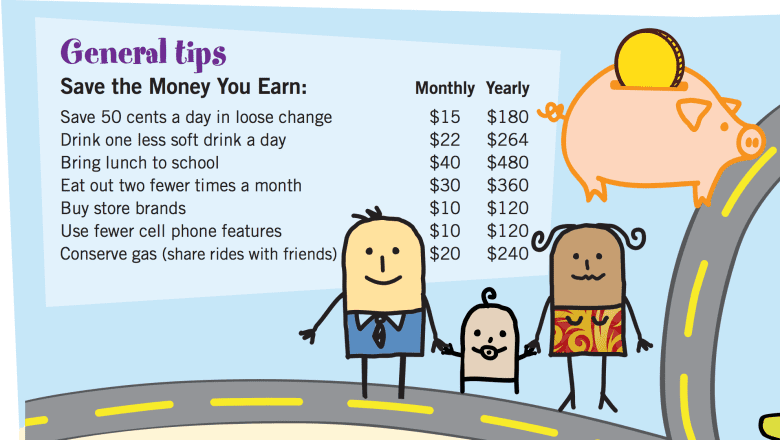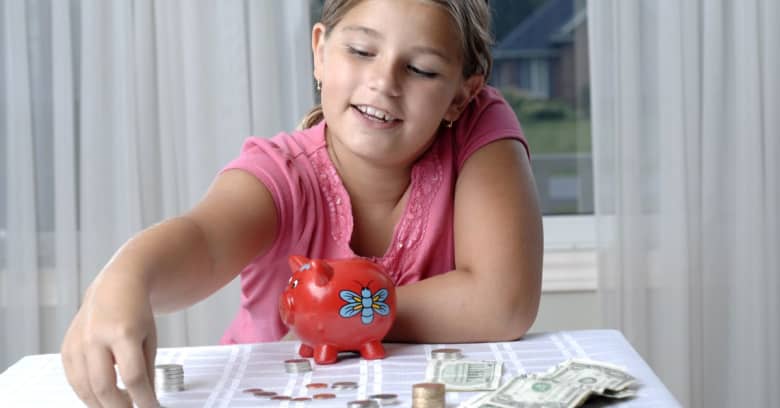How to Teach Kids About Money at Every Age

Want your kids to do better than you financially? Want them to keep a budget and invest in their future? Financial education is key.
A 2018 National Financial Capability Study found financial education correlated with good financial behavior like saving more, spending less than you earn, and being less likely to overdraw a checking account. It reported, “49% of respondents who received more than 10 hours of financial education report spending less than they earn, compared to 36% among those who received less than 10 hours.”
While it’s never too late to learn, the earlier you learn financial literacy, the greater the long-term impact. That’s why we've compiled money methods to teach your kids about finances at every age.
Toddlers

Kids start learning the moment they are born. Initially, this learning is imitation based, like following a parent’s lead to smile, track objects, and say their first words. Whether you know it or not, they are learning and picking up your habits.
Start early by setting a good example for them to follow later. The habits they’ll pick up include developing a budget at the grocery store, paying bills on time, and resisting impulse buys. When you discuss your decision-making with your toddler, they’ll learn how to make better decisions on what to (or not to) buy.
Preschoolers and Kindergartners

While kids at this age may not understand the value of money, they should understand the need to pay for merchandise. Kids learn from shared experiences, so include them in the grocery trip to help them understand this process. To make it more tangible, leave the credit cards at home and use cold hard cash.
By 7 years old, we develop basic financial behaviors, according to a University of Cambridge report. Before you panic and think your kids are already behind, they’ve probably addressed the basics: counting and exchange.
-
Counting
This starts with simply counting objects, but should grow to include counting coins and dollars. Show kids the different kinds of coins and bills, allowing them to recognize the differences, group them, and then count that specific set. -
Exchange
One of the hardest lessons to learn at this age is that something must be given up to make a purchase. Money can only be spent once. To teach this, give a child one dollar to spend in the store and focus on choosing an item they really want. The child must hand over that dollar to purchase the item and experience the exchange of goods.
First to Fifth Grade

Source: Junior Achievement
With a basic understanding of the purchasing power of money, your grade-schooler probably now wants more. It’s time to explain how to earn money, save it, and what opportunity costs are. The Federal Deposit Insurance Corporation (FDIC) has classwork suggestions to help teach these principles at school or home.
-
Earning money
Unfortunately, your mother was right and money does not grow on trees. It is earned, and for kids at this age, it should be earned with chores. Rather than an allowance, reward work with personal funds. This teaches the ultimate lesson in finance: it takes work to earn money.
Kids who earn their allowance are in the majority. A Junior Achievement USA survey found 82% of the children earned an allowance for doing chores, getting good grades, doing homework and simply being kind to others at school and at home. -
Saving
It’s time for a piggy bank or maybe a mason jar, instead. A clear mason jar allows a child to see the money grow over time. It helps reinforce the benefits of saving. It’s also important to introduce children to the benefits of banks. Take them to the bank with you to deposit money, explaining the benefits of saving money there versus at home. Most banks and credit unions offer savings accounts for children — and many pay interest on deposits.
It’s also important to explain why you save: short-term needs, long-term goals and establishing an emergency fund. Provide scenarios to explain how you save and why. Honesty will help them learn and appreciate real-world finances.

Source: American Bankers Association
-
Opportunity cost
A fifth-grader should be able to understand opportunity cost, even if you don’t use that term. Opportunity cost is the loss of potential gain from other alternatives when one alternative is chosen. You can help your child understand impulse buying versus long-term goals. It’s a constant battle that we begin learning at this stage. Explain the difference between needs and wants, and how to prioritize them. We all have impulse buys, but we must learn to recognize them and limit them.
Sixth to Eighth Grade

At this stage, you’ve established a lot of great money principles for your middle-schooler. The next stages focus on expanding on those basics concepts with income, budgeting and contentment.
-
Income
What do you want to be when you grow up? The question at younger ages elicits a cute response. By middle school, though, it’s a real conversation about the need to find a career that will support you for a lifetime. Explore different job options and discuss both their responsibilities and their paycheck. This is also a good opportunity to explain why your salary isn’t how much you take home. Explain taxes, Social Security, insurance premiums, and other deductions from your paycheck. -
Budgeting
While your child doesn’t need a personal budget right now, it’s a good idea to learn how to set one. Include them in your budgeting, asking for input on financial decisions like meal planning for the grocery budget. -
Contentment and giving
“Mark got a new iPhone. I need one too!” It’s easy to compare ourselves to others, and for pre-teens and teenagers, the pressure is even greater. Kids at this age need to learn contentment — being satisfied with what they have rather than trying to keep up with the Joneses. Even better, they need to learn to appreciate what they do have. If they don’t already, kids should understand the benefits of giving back and donating to charity. Volunteering or donating items is a good lesson for all of us.
Looking to check your child’s financial literacy progress? Jump$tart Coalition created national standards for educators to set financial literacy goals. It’s a good goal for parents too. The benchmarks by eighth grade include:
- Set spending priorities to reflect goals and values.
- Discuss the components of a personal spending plan, including income, planned savings and expenses.
- Compare saving strategies, including “Pay Yourself First” and comparison shopping.
- Illustrate how inflation and interest can affect spending power over time.
- Justify the value of an emergency fund.
High-Schoolers

Teenagers are looking for and need new levels of independence. It’s not long before they are off on their own. Many of the lessons at this stage are firsthand experiences with a checking account and budgeting for college.
-
Personal accounts:
While your teen may not use the traditional check register you learned with, every teen needs to know how to balance a checking account. Personal checking and savings accounts do not establish credit, but they do show an ability to handle your finances. While a checking account is all a teenager technically needs, it’s a good idea to open a savings account as well (if you haven’t done so already) so they can include deposits to both accounts in their budget and see firsthand the impact of compound interest. -
Credit cards:
Our society relies heavily on credit cards, which can have their benefits. However, they may also include high fees and interest charges, even more so for those with limited or no credit history. Teenagers must learn the dangers of credit cards and how to use them wisely. Teach them to pay off the balance and avoid buying things they can’t pay off each month. A good way to explain interest charges is to look at the interest a bank pays you on a savings account versus what a credit card charges you to use their money. Investigate student credit cards together to learn which one is the right one for your teen.
More: Do Debit or Credit Cards Make Sense for Your Child?
-
Paying for college:
The cost of college is skyrocketing, and so is student debt. As you and your teenager prepare for the next step, compare the costs together, and discuss how you’re going to pay for college. Not every high schooler needs to go to college, and some schools are much more expensive than others. Along with college options, research available scholarships and loans. The decisions you make now will influence the rest of your life.
Learning how to handle money is a lifelong process. However, the earlier your child embraces good financial habits, the more likely they are to find financial success.
Blogs are not written by MNC Staff.
Original article can be found here: https://www.moneygeek.com/financial-planning/resources/how-to-teach-your-kids-about-money/
